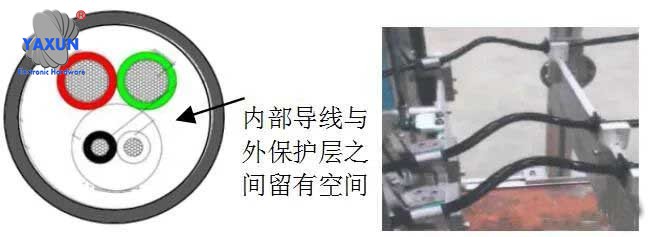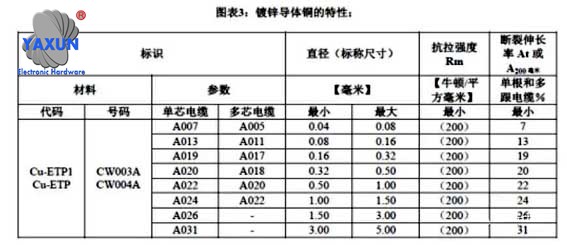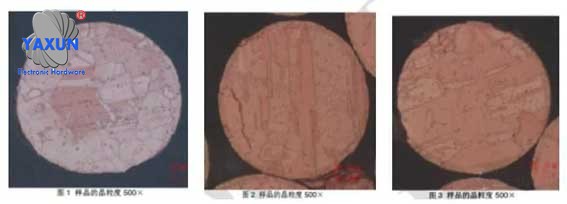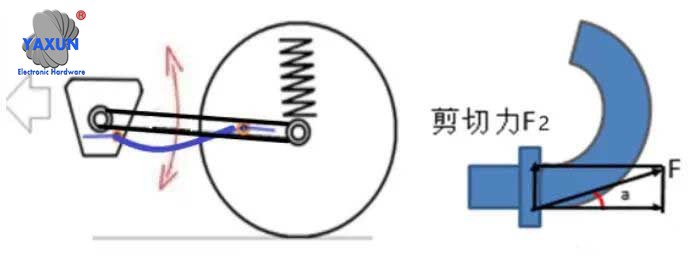Aiming at the breakage problem of automobile EPB wire harness in the simulated bending test of the real vehicle. In this article, wiring harness engineers comprehensively analyze the factors related to wire fracture, and combine experimental analysis methods to analyze and evaluate the reliability of automotive EPB wire harness wires against bending fatigue fracture. Several solutions are proposed and their implementation effects studied. The results show that it is more practical to optimize the copper conductor grain size and wire structure, increase the number of core wires, and reduce the volume ratio of the outer protective sheath of the wire. It can effectively reduce the probability of automobile EPB wiring harness wire breakage.

Automotive EPB wiring harness working environment
0 Preface
With the rapid development of the automobile industry, automobile safety is the first indicator of automobile design and manufacturing. By using modern technology and advanced means, various possible ways and solutions to further improve safety can make cars as a means of transportation safer. As a braking system, the PEB system is a major safety system and an important factor in measuring automobile safety standards. The extensive application of EPB electronic parking systems in automobiles plays an important role in improving the safety and ride comfort of automobiles. The EPB wiring harness is an integral part of the system, and its reliability directly affects the reliability of the entire automotive EPB system. This article mainly studies the reliability of automotive EPB wire harnesses against bending and fracture.
As part of the automotive wiring harness, the automotive EPB wire harness integrates EPB wires and ABS wires and is installed in the suspension area of the body chassis. This part is subject to both impact and corrosion from the outside of the car body, as well as a large amount of mechanical movement from the longitudinal swing arm. Zato, PEB places high requirements on the bending resistance of the wire harness. When the car is driving due to uneven road conditions, the swing of the longitudinal swing arm in the body chassis suspension system pulls the EPB wire harness into continuous high-frequency bending, causing the wires in this section to bend and break. This failure mode is the focus of this article.
Figure 1, automotive EPB wiring harness working environment and EPB system structure
Automotive EPB (Electrical Park Brake) system is the abbreviation of electronic parking system. It replaces the traditional lever handbrake but is safer and does not change the braking effect due to the driver’s strength. Turn the traditional lever handbrake into a button within easy reach. It is a technology that realizes parking brake by electronic control.
The system includes EPB push button switch, electronic control unit ECU, automotive EPB wiring harness and ABS wiring harness, ABS speed sensor, brake motor, reduction gear mechanism and brake caliper and other components. The ABS speed sensor converts the vehicle speed signal detected during driving of the car into an electrical signal, and transmits the electrical signal to the ECU through the EPB wiring harness. The ECU then issues instructions to control the brake calipers to brake the wheels. The EPB wire harness plays the role of a bridge for transmitting electrical signals.

Elongation at break of wires with different coatings
2 EPB wire bending and fracture phenomena and related factors
2.1 Wire breakage phenomenon
The EPB wire harness is fixed to the support arm and longitudinal swing arm of the body chassis through wire harness rubber sheaths, plastic buckles, brackets and other parts. When the car is driving, the wheels bump up and down due to the uneven road surface, which causes the longitudinal swing arm on the chassis to make a reciprocating motion similar to a pendulum around the fixed point of the body support beam.
The EPB wire harness bending test simulates the movement of the wire harness in the real vehicle environment, bending and swinging at a frequency of 2.5Hz in the range from -30°C to normal temperature. The test requires that the wire harness be bent a number of times within the required lifespan to ensure no damage to the appearance of the wire harness and no signal interruption. The bending test found that the breaking position of the wire harness was near the fixed point of the moving section.

Metallographic analysis of broken wire cores
Figure 2, Wire harness breakage and cross-section view
Photos of the fracture location and cross-section of the conductor during the test show that the core wire fracture surface has both a flat cross-section and a rounded cross-section similar to that of a bullet. It shows that the copper conductor is subject to both shear force and tensile force when subjected to external forces.
2.2 Conductor force analysis
When the vehicle is driving, the EPB wire harness is pulled by the longitudinal swing arm of the body chassis to form high-frequency symmetrical bends, causing local bending, deformation and damage to the wires. The accumulation of local cyclic plastic deformation is the fundamental cause of metal fatigue damage. Its bending form and stress analysis are as follows.
Figure 3 Wire harness bending principle and force diagram
The copper wires are severely stretched and deformed in the outer area of the arc, and mutual extrusion deformation is formed in the inner area of the arc.
① Axial tensile force F1: Vehicle bumps cause the longitudinal swing arm to swing up and down, and the wire harness is pulled in a certain direction and bends. An angle ∠a is formed during this process, and the traction force F generates an axial pulling force F1 in the direction ∠a; F1=F*Cos a, and the decrease in the angle a will cause the axial pulling force F1 to increase.
② Radial shear force F2: The wire harness is pulled in a certain direction and bends, forming an angle ∠a. The traction force F produces a component force in the ∠a direction, which is the shear force F2; F2=F*sin a, and the increase in the angle of a will cause the shear force F2 to increase. Repeated alternating tension and shear forces cause slight deformation of the core wire. The superposition of hundreds of thousands of tiny deformations ultimately leads to the failure mode of fatigue fracture.

Bending stress of connecting wire harness
2.3 EPB wire harness conductor material
2.3.1 The EPB wiring harness is an automobile wiring harness, and its wires are made of multi-core copper wires. The physical properties of the copper material in the core wire determine the basic mechanical properties of the EPB wire harness conductor. Copper is a metal crystal. The relationship between the size of the grains and the strength of the metal shows that the smaller the grains, the better the mechanical properties of the metal such as strength, toughness, and plasticity. Grain refinement is one of the important means to improve the mechanical properties of metals. From the Hall-Petch relationship:
σy represents the yield limit of the material;
σ0 represents the lattice friction resistance produced when moving a single dislocation;
Ky is a constant related to the type and nature of the material and the grain size;
d average grain diameter.
The effect of grain refinement on metal strength is described by the H-P relationship. The metallographic structure test shows that the crystal grain size in the metallographic structure of the broken copper wire is relatively large, the average grain size, and the uniformity of the grains affect the toughness and strength of the copper core wire. See Figure 4.

Broken section of wire harness
Figure 4 Metallographic analysis diagram of broken conductor core wire
2.3.2 The ratio of copper material in the EPB wire harness core wire affects the elongation at break of the core wire. The conductors in this case use tin-plated core wires, which reduces the proportion of copper in the core wires.
Figure 5 shows that the elongation at break of tinned copper core wire is smaller than that of bare copper core wire. The galvanized copper core wire with reduced elongation at break reduces the bending resistance of the EPB wire harness and increases the risk of breakage.
Figure 5 Elongation at break of wires with different coatings
2.3.3 The wire structure affects the toughness of the wire, thereby affecting the bending resistance of the EPB wire harness. The greater the number of core wires, the higher the overall toughness of the wire, which is more conducive to EPB wire harness resistance to fatigue fracture caused by bending. The wires of the EPB wiring harness in this case include 2 2.5mm2 copper wires and 2 0.5mm2 copper wires.
Among them, the core diameter of the 0.5mm2 wire is 0.15mm, and the number is 28. The number of core wires is too small and the diameter is too large, which affects the overall mechanical properties of the conductor.
2.4 Analysis of EPB wire harness outer protective layer
The integrated cable of the broken EPB harness contained four conductors and an outer protective layer of PVC material. Its protective layer is closely attached to the four wires, almost like a rigid body. Analysis shows that the four wires inside the outer protective layer lack buffer space during the bending process and are difficult to expand or contract, causing severe stress concentration and breakage.
2.5 EPB wiring harness installation point analysis
The EPB wiring harness is fixed to the body chassis through mechanical interference fit. The mounting points are made of polyurethane elastomer PUR, with a material hardness of 95A. The lack of rounded edges, lack of elasticity and buffering effect when subjected to force is another factor that causes EPB wire harness breakage. In this case, the lack of elastic buffering and the energy absorption effect on bending stress lead to fatigue fracture due to shear stress concentration at the fixed point of the wire harness.
2.6 EPB harness length analysis
After test analysis, the length of EPB harness wires has limited size margin in the dynamic region. There is obvious tension in the harness between the two fixed points. During the bending process, while the moving area of the wire harness is subjected to tension, the increase in the bending angle intensifies the concentration of shear stress, causing the wire harness to break.
3 Optimization plan and experiment
The design and selection of automotive wiring harness wires needs to focus on the function and environment of the wiring harness. The EPB wire harness is installed in the dynamic bending area of the body chassis and the car parking system determines that the EPB wire harness is a special car wire harness and is a safety part. suggestions below:
3.1 Define the wire type based on the bending resistance requirements, and select bare copper with high grain size and ultra-flexible wires with a large number of core wires to meet the bending life requirements. In order to ensure the strength of the wire, the minimum cross-sectional area of the automotive wire should not be less than 0.5mm2. According to German standard LV112-1, choose ultra-flexible bare copper wire:
3.2 Define the external protective layer and cross-sectional structure of the wire based on the stress requirements to effectively transmit and channel bending stress. Choose the structure of wire plus casing, and define the wear resistance grade and temperature grade of the material. Reasonably set the volume ratio of the conductors in the casing so that the conductors can expand and contract within a small range and reduce stress concentration.
3.3 Determine line length and tolerance based on force requirements. Generally speaking, the length of each part of the automobile wiring harness is determined based on the actual placement of the electrical appliances on the body. The actual tolerance should take into account the wiring harness assembly requirements and their interference problems under dynamic and static conditions. Due to the influence of shear force during bending motion, the length should be slightly extra according to the actual length of the line. Generally speaking, the redundancy is between 3% in 5%.
3.4 Define mounting point materials based on stress requirements. Reduce the hardness of the EPB wire harness fixed point material PUR to 75A, eliminate the right-angled edges of the fixed point, increase rounding corners, reduce stress concentration, and improve the bending resistance life.
3.5 Perform a bending test after optimizing the EPB harness as mentioned above. The bending angle of the wire harness on the bench decreased, and the stress concentration was significantly reduced. After the entire wire harness bending test reached 1 million times, the wire appearance was flawless, no breakage occurred, and the electrical signal transmission was normal.
Figure 6 Optimized cross section and optimized bending test

Optimized conductor cross-sections and bending tests
4 Conclusion
① The potential causes of EPB wire harness breakage are analyzed in depth based on the location where the car EPB wire harness breaks, the broken cross section, the material of the wire, and the installation method.
② The experimental method was used to conduct an in-depth analysis of the stress on EPB wire harness breakage and confirm the cause of EPB wire harness breakage.
③ Formulate a material selection plan for the multi-core copper conductors of the automotive EPB wiring harness, and define the principles for the outer protective layer of the conductors, the length of the wire harness in the movement area, and the material hardness of the installation point. Through comparative analysis before and after the implementation of the improvement plan, the accuracy of the optimization plan was verified and provided a reference for the analysis and solution of similar problems.
 English
English العربية
العربية Български
Български 中文(漢字)
中文(漢字) Čeština
Čeština Dansk
Dansk Eesti keel
Eesti keel Suomi
Suomi Français
Français Deutsch
Deutsch Ελληνικά
Ελληνικά עברית
עברית Magyar
Magyar Bahasa Indonesia
Bahasa Indonesia Italiano
Italiano 日本語
日本語 한국어
한국어 Latīna
Latīna Latviešu valoda
Latviešu valoda Lëtzebuergesch
Lëtzebuergesch Polski
Polski Português
Português Română
Română Русский
Русский Slovenščina
Slovenščina Español
Español Svenska
Svenska ภาษาไทย
ภาษาไทย Tiếng Việt
Tiếng Việt
